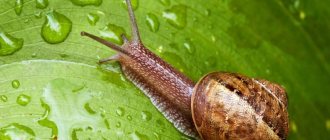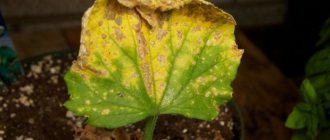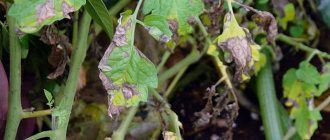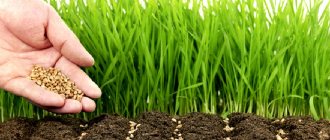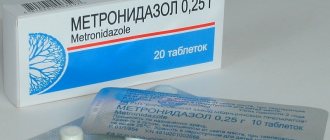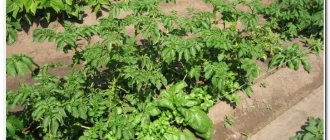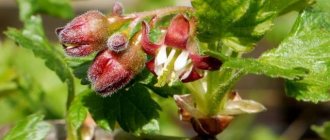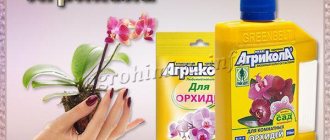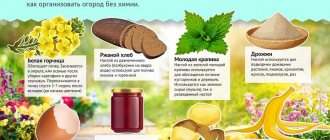How is iodine useful for tomato seedlings?
Iodine is involved in the vital functions of tomatoes - metabolic, respiratory and photosynthetic processes, the synthesis of amino acids, and is also a natural antiseptic. With regular use, there is no need to apply large doses of nitrogen compounds, due to which nitrates accumulate in the soil and vegetables.
Lack of the substance leads to the spread of diseases, slow development, and reduced yields. Other crops suffer less from a deficiency of this microelement.
If the permitted dosage is observed, iodine as a fertilizer for tomatoes does not cause harm to the environment and human health. It can be safely used at any stage of the growing season.
Feeding tomatoes with iodine restores the balance of elements in the soil and promotes:
- increasing germination and rapid germination of seeds;
- strengthening the immune system;
- increasing resistance to adverse factors;
- the formation of a large number of ovaries;
- disappearance of fungal diseases.
An iodine solution helps fight late blight and powdery mildew, which cause great damage to the crop.
Many gardeners believe that thanks to iodine fertilizing, tomatoes acquire a rich red hue.
Benefits and harms
The benefits of treating tomatoes with iodine are as follows:
- Tomato seedlings tolerate picking easier and take root well in the garden.
- Nitrogen metabolism in the stems and leaves of the plant improves.
- Tomato seedlings grow much faster, and young bushes in the garden begin to actively form green mass.
- Plants develop strong and healthy root systems.
- Tomatoes become more drought-resistant.
- The crop tolerates the consequences of excessive soil moisture more calmly.
Fertilizing tomato seedlings with iodine solution has a beneficial effect on human health. For example, in some varieties of this vegetable, with such fertilizing, vitamin C accumulates in the fruits. And the taste of the fruits increases several times.
Does this method have any disadvantages? As such, no disadvantages were found in feeding tomatoes with iodine. But it should be remembered that an excess of this element can be harmful to both plants and humans. Tomatoes accumulate iodine compounds, part of which enters the fruits, which are then used as food. Therefore, it is important not to overdo it with watering plants with iodine-containing solutions .
In what cases is it necessary to treat tomatoes with iodine?
Visually identifying a microelement deficiency is quite difficult. The main symptoms are persistent illnesses that occur due to reduced immunity. Plants react more acutely to drought, excessive watering, temperature changes, and exposure to pests.
Characteristic signs of iodine deficiency:
- The seedlings wither: the leaves turn pale, lose turgor, the stems become thinner.
- Late blight, mosaic, and root rot are spreading. After treatment, the tomatoes get sick again because their immune system is not working well.
- Flowering and fruiting are delayed. If the deficiency is not corrected, the tomatoes will grow small and remain green. In case of acute starvation, the entire harvest will be lost.
The need of plants for iodine is thousandths of a percent, so simple fertilizers containing only this substance are not produced. The trace element is present in wood and peat ash, manure, phosphate rock, and some complex compounds. However, it is much easier to use a medicine that is in any first aid kit.
How do you know if plants need iodine?
Iodine is sufficient in chernozems, lowlands and coastal areas. The further a region is located from the sea, the greater the deficiency of this element.
When there is a lack of iodine in the soil, acidification and an excess of chlorine and calcium are observed.
Signs of iodine deficiency in plants:
- susceptibility to diseases and pest attacks;
- the leaves turn pale, and the stems become thinner and elongated;
- the seedlings wither and wither over time.
Lack of iodine causes symptoms that are similar to those that occur with nitrogen deficiency and freezing.
Features of use in greenhouses and open ground
Tomatoes need to be fed with iodine both in open and protected ground. In the latter case, the procedure is especially useful - the room is always warm and humid. Such an environment is favorable not only for the development of plants, but also for the proliferation of pathogenic bacteria.
Before the start of the season, the greenhouse is disinfected:
- remove debris and plant debris, clean walls;
- treat the surfaces with a 1% solution of potassium permanganate;
- fumigated with charcoal.
Be careful when working in confined spaces. Iodine is a volatile substance. Inhalation of vapors may cause deterioration of health: irritation of the upper respiratory tract, lacrimation, dizziness and headache. It's better to wear a respirator.
Before planting seedlings in open ground, the soil is treated with iodine solution (3 drops per 10 liters). The liquid will destroy pathogenic microorganisms, which will reduce the likelihood of future illnesses.
Methods of feeding
Vegetable growers use 2 main methods of fertilizing: root and leaf spraying. In the first method, the nutritional composition is poured under the roots of plants. The second method involves applying a nutrient composition to the leaves and stems of plant organisms. To achieve maximum effect, you should alternate these two methods of fertilizing.
Important! When fertilizing with iodine-based solutions, the concentration should never be exceeded. This is fraught with negative consequences.
As an optional feeding method, you can consider soaking the seeds in a nutrient solution before planting. This technique allows you to protect plant sprouts at a very early stage from pathogens of fungal and bacterial diseases and provide nutrition with a certain element.
Disinfection of seeds before planting
Seed preparation is of great importance in obtaining a high yield. Iodine kills pathogenic bacteria, speeds up the emergence of seedlings, and makes them more “friendly.” In the future, tomatoes get sick less and show resistance to unfavorable conditions.
Purchased planting material covered with a nutrient coating is not processed.
For disinfection:
- add 0.1 g of iodine to 1 liter of warm water;
- immerse the seeds for 10 minutes;
- the liquid is drained;
- planting material is washed with running water.
At the end, the seeds are sorted and dried in the sun, spread on a napkin or towel, for 7 days. Damaged copies are thrown away. Dark spots indicate that the seeds are already infected - germination will be low. High-quality planting material is wrapped in a paper or fabric bag and processed in the standard way.
You can use a hot solution at a temperature of +50…+60 °C. Then all weak or infected seeds will die.
Preparation of seed material
To speed up the ripening of fruits, the gardener needs to worry about this already at the stage of processing the seed material. If you heat the seeds at a temperature of 45 degrees in a thermos for 2 hours, then soak them for 20 minutes in a strong solution of potassium permanganate and 15 drops of iodine, they will germinate faster.
It is effective to soak the seeds in a solution of boric acid and iodine (0.2 g of acid, 5 drops of iodine tincture per 1 liter of water) for a day.
The following recipe is very effective: take 2 tbsp for 1 bucket of water. l. a mixture of Kalanchoe and marina root juices, 1 g each of succinic and boric acid, 1.5 g of zinc sulfate, 1 g of manganese sulfate, 15 drops of iodine. Soak the seeds for 48 hours. This nutrient solution ensures high seed germination, suppresses diseases, increases cold resistance and stimulates the growth of tomatoes.
The same mixture can be sprayed on seedlings after three or four true leaves appear. When using such a nutrient mixture, no further feeding or treatment is required for the seedlings.
Feeding and watering tomatoes
Fertilizers are applied to moist soil to avoid burns and improve the absorption of nutrients. When watering, it is important to follow several rules:
- use warm, settled water;
- Direct the stream strictly to the root, avoiding contact with the leaves: tomatoes do not like sprinkling;
- the best time is morning or evening, cloudy weather, temperature above +18 °C;
- do not moisten the soil for 10 days after transplanting or picking;
- Avoid watering during cold weather, as the risk of infection with fungal diseases and late blight will increase significantly.
How to feed?
Liquid fertilizing with iodine can be applied in two ways: foliar and root. Alternation of species will be most effective, since this will give the best result both in terms of treating tomato bushes and in terms of preventing their diseases.
Seedling
For the proper development of tomato bushes and their fruits, fertilizers with iodine must be applied in the early stages of crop maturation , at the stage of seedling formation at home. This will help young plants grow well and develop properly. The bushes will gain strength in order to successfully undergo replanting and take root in a greenhouse or open ground.
But you need to start watering tomato seedlings at the right time and you need to do it correctly. Based on the experience of home garden vegetable growing, the most optimal time for the first feeding of seedlings with iodine is the period when the second pair of true leaves forms on the bushes. At this stage, root or foliar fertilization of plants with iodine solution is performed.
For foliar treatment you will need the following composition:
A glass of low-fat milk is diluted in 1 liter of warm water and 5 drops of alcohol tincture of iodine are added.- The resulting composition is sprayed on the above-ground parts of tomato seedlings.
- It is better to carry out the procedure early in the morning or after sunset.
- The iodine composition must be evenly distributed over the entire surface of the plant.
Root feeding is most often used for growing seedlings in a greenhouse and consists of the following:
- For a ten-liter bucket of room temperature water you will need 10 grams of iodine tincture.
- Each bush needs to be watered at the very root with 500 ml of solution.
- It is better to carry out this procedure in the morning or evening.
Watch a video about feeding tomato seedlings:
Mature bushes
Root method of application
Preparation is as follows:
- Dissolve 3 liters of sifted ash in 5 liters of hot water, cover the container with the solution and leave for at least an hour.
- Then dilute the infusion with warm water so that the total volume ends up being 10 liters.
- Next, pour in a 10 ml bottle of iodine and add 10 g of boric acid. Mix the resulting solution thoroughly and leave to infuse for a day.
- To water plants, dissolve 1 liter of solution in 10 liters of warm water.
- Watering is carried out at the roots of plants.
Foliar application method
- Dissolve 250 ml of low-fat milk in 1 liter of warm water.
- Then add 5 drops of iodine and mix thoroughly.
- You can spray the tops with this composition in the morning or evening.
- You should not water the bushes too much, since if the dosage of iodine is exceeded, burns may appear on the leaves of the crop.
To prevent infection of plants by pathogenic microflora, a small amount of crystals of potassium permanganate can be added to the fertilizer.
Use of iodine in mixture with other substances
Combined feedings enhance the effect of iodine and allow you to quickly obtain the desired effect. The most common and productive recipes are shown in the table.
| Target | Compound | Watering | Spraying |
| Destruction of powdery mildew pathogens | For 3 liters: 350 ml of milk, 4 drops of iodine. Suitable for cucumbers. | + | + |
| Acceleration of seedling development | 1 liter of milk, 8 drops of iodine. | + | – |
| Feeding the earth with organic matter | For 10 l: 1 l of whey, 15 drops of iodine. | + | – |
| Fight against late blight | For 1 liter: 1 ml of iodine, 4 drops of brilliant green. Alternative option for 10 liters: 10 drops of iodine, 1 liter of sour milk, 20 g of laundry soap. | – | + |
| Increased disease resistance | For 10 l: 10 g of orthoboric acid, 10 drops of iodine. | – | + Three times per season: before and during flowering, during the formation of ovaries. |
Advantages and disadvantages
Let's talk about the pros and cons of iodine-based fertilizer:
First the advantages:
- Availability of the active substance;
- Efficiency;
- This is an assistant in the fight against fungal diseases;
- The drug actively interacts with other substances, which allows you to create an effective complex remedy.
And now the disadvantages:
- Difficult to dose without a dropper;
- The danger of excess iodine in the working solution;
- It is effective only in cases of iodine deficiency and does not replace other supplements.
Some mistakes gardeners make
In order not to get the opposite effect from iodine supplementation, you need to follow some rules:
- Do not disturb the plants immediately after transplantation - they must adapt to the new location and restore the root system. You should wait at least 10 days.
- Do not prepare concentrated solutions - the recipes indicate the optimal dosage, which is well accepted by tomatoes. You cannot increase the amount of iodine - fertilizing will be harmful.
- Do not use solutions with boric acid too often - excessive doses of boron provoke leaf necrosis and lead to cracking and distortion of the fruit.
Iodine is an effective and safe fertilizer for tomatoes. Proper feeding prevents the occurrence of diseases and increases productivity. But do not forget that plants also need other elements, which also need to be added to the soil.
How to carry out foliar feeding
Foliar feeding (foliar feeding) is spraying plants with a working solution from a spray bottle or garden sprayer.
The fact is that plants receive microelements not only through the root system, but also through the above-ground parts (leaves and stems). Therefore, such feeding also takes place.
By the way, in order to increase the effectiveness of the drug, it is recommended to alternate root and foliar feedings.
ON A NOTE. When spraying, it is better to slightly reduce the concentration of the active substance.
Signs of iodine deficiency
A lack of iodine in tomatoes has a detrimental effect on them and becomes noticeable even for novice gardeners:
- there is a decrease in the immune forces of plants, as a result of which they develop fungal and viral diseases;
- seedlings grow thin and weak;
- fruiting deteriorates;
- often the ovaries do not develop or they stop forming altogether, although the bush may look quite healthy;
- the bushes stop growing and developing, their tops dry out, while the side shoots continue their active growth;
- Dead areas are noticeable on the leaves.
The effect of iodine and boric acid on plants
Iodine and boric acid are trace elements that plants do not need in significant quantities. But even this small norm is sometimes vital for them. And if we take into account that these elements are practically not present in ready-made mineral supplements, and they do not reach plants separately under natural conditions, then the need for additional treatment of tomato bushes with iodine and boric acid becomes relevant, no matter where they grow - in a greenhouse or outdoors. space. Their role for tomatoes can hardly be overestimated. But many are interested in whether tomatoes can be treated with these substances and how to do it correctly.
pros
- Proper treatment of tomatoes with an iodine and boron mixture has a positive effect on plants:
- nitrogen exchange improves, which makes it possible not to use nitrogen fertilizers, for example, saltpeter;
- Fruiting becomes more abundant, yields increase;
- the protective properties of plants against harmful microorganisms are enhanced, the level of disease in tomatoes is reduced;
- especially effective in preventing late blight;
- the development and growth of plants and fruits, their appearance noticeably improves, and the formation of ovaries is more productive.
Minuses
- If you use these substances thoughtlessly and incorrectly, you can get the opposite negative result, which will not only not eliminate the problems of tomatoes, but will also worsen them:
- an overdose of these microelements makes them a real poisonous agent that can lead to plant burns;
- leaves turn yellow, curl at the edges, bend, dry out, die and fall off;
- the plant may die.
Signs of a substance deficiency
Isotope deficiency adversely affects the growth and development of tomatoes in greenhouses and open ground. Visually, you can identify the following typical manifestations of microelement deficiency:
- Sluggish, weak stems, thin shoots, pale leaves.
- Weakened immunity. Reduced resistance to infections and parasites.
- Increased susceptibility to disease. Frequent infection with late blight, rot - apical and root.
- Reduced productivity. Harvests reach a minimum or are completely absent.
- Poor resistance to temperature fluctuations, recurrent frosts, heat and drought.
In the absence of iodine supplements, productivity sharply decreases, tomatoes quickly and in large quantities die due to diseases.

